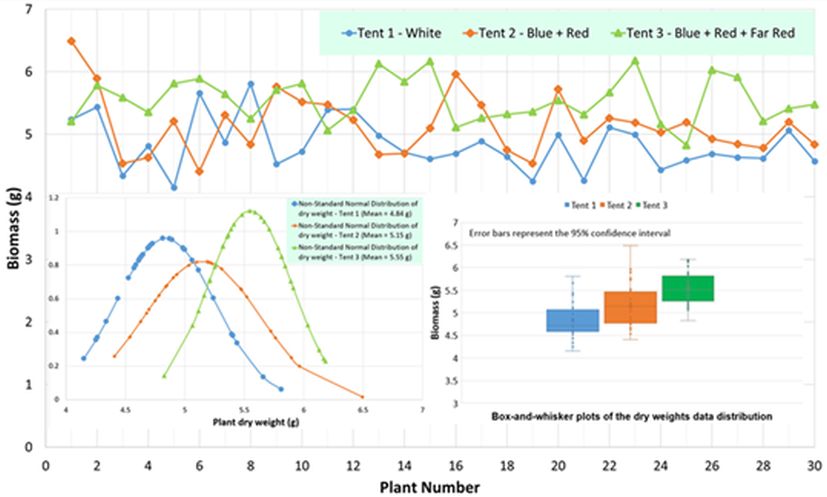It is now time for the future generation and advanced greenhouse design practices to address a range of issues, from energy and land use efficiency to providing plant-optimised growth techniques. In this encyclopaedia record, we report on the practical development of spectrally selective and specialist-type advanced metal-dielectric thin-film filters that produce the optimum illumination spectrum when exposed to sunlight that can help maximize the biomass productivity of glass greenhouse crops ( our experimental case study has been performed for the lettuce species, Lactuca sativa, L., yielding promising results).
- Greenhouse agriculture
- Lactuca sativa
- spectral optimization
- energy efficiency
According to the United Nations Food and Agriculture Organisation (UN FAO), by the 2050, the world population can be 39% bigger than that of 2006, which can steer potentially a food crisis for its large population along with other basic needs such as energy and power. The world population as well as the agriculture industry, will be benefited if the greenhouse crops could be mass-produced with minimal energy use, in an efficient manner, whilst maintaining the nutritional quality, simultaneously with achieving increases in the biomass growth productivity. Advanced growth technologies, such as innovative greenhouse production methods, e.g. spectrally-shaped illumination for plants, are widely expected to provide the practical solutions in near future[1][2][3][4][5].
We experimentally determined the wavelength range(s) of visible electromagnetic radiation using an artificial combination-wavelength light source that are required to obtain improved biomass productivity in the plants like lettuce. After that, based on the obtained spectral illumination filtering results, we designed and developed thin-film optical filters for application to glass for use on the roof or walls of a greenhouse. The thin-film optical filter will pass through only the solar spectral components required for optimized biomass growth of the sample plant (lettuce). Alternatively, the same thin-film components can be used to filter a range of broad-bandwidth artificial light sources used at night time, to further boost the overall greenhouse productivity, simultaneously with reducing the heat load inside greenhouses. Figure 1 (reproduced from Ref.[6]) shows a metal-dielectric thin-film filter developed at the Electron Science Research Institute’s (ESRI) nano/micro fabrication labs. This special type of spectral filter can usefully modify the incoming natural sunlight.
Figure 1: (a) filter image taken with the sample placed next to the glass of a conventional window; (b) filter chromaticity diagram, modeled in both the transmission and reflection; the measured reflected-colour Hunter Lab parameters (L, a, b) are also shown; (c) spectral modification of the natural sunlight (standard AM1.5G spectrum) on transmission through either the low-iron ultraclear 6mm glass, or through the thin-film filter developed.
Lactuca sativa L. was considered for the experimental investigation, as it is a quantitative long-day plant at high temperatures and a day-neutral plant at low temperatures[7]. Lettuce can be cultivated in long day growth mode, although it is a long-day plant, because premature flowering effects can be controlled by using an appropriate temperature. Production yields can be maximized, provided that both the irradiation timing and the ambient temperature are optimally controlled, when the length of day exceeds the length of night that the plant is detecting. A detailed background literature study together with all the possible experimental procedures and test results are explained in detail, and are available in the recently published preprint[6]. Figure 2 shows a presentation of raw data on the dry biomass obtained from each of the samples in each of the grow tents, together with the graphical analysis of the relevant data distributions.
Figure 2. A graphical presentation of relevant statistical data analysis of each of the grow tents, and the biomasses obtained by each plant within each tent (total of 90 plants).
A comprehensive study has been conducted to optimize the wavelength range of visible light that can improve the biomass growth of the sample plant Lactuca sativa, L.
A passive solar thin-film filter design suitable for use in existing low-emissivity energy-harvesting solar window products has been prototyped for use in agricultural greenhouses. It can be expected that future lettuce growth experiments in advanced pilot greenhouses using spectrally optimized solar windows will reconfirm the biomass improvement results reported.
References
- Giacomo Tosti; Paolo Benincasa; Rossano Cortona; Beatrice Falcinelli; Michela Farneselli; Marcello Guiducci; Andrea Onofri; Euro Pannacci; Francesco Tei; Mario Giulietti; et al. Growing lettuce under multispectral light-emitting diodes lamps with adjustable light intensity. Italian Journal of Agronomy 2017, 11, 6, 10.4081/ija.2017.883.
- Kuan-Hung Lin; Meng-Yuan Huang; Wen-Dar Huang; Ming-Huang Hsu; Zhi-Wei Yang; Chi-Ming Yang; The effects of red, blue, and white light-emitting diodes on the growth, development, and edible quality of hydroponically grown lettuce (Lactuca sativa L. var. capitata). Scientia Horticulturae 2013, 150, 86-91, 10.1016/j.scienta.2012.10.002.
- Chung-Liang Chang; Kuang-Pi Chang; The growth response of leaf lettuce at different stages to multiple wavelength-band light-emitting diode lighting. Scientia Horticulturae 2014, 179, 78-84, 10.1016/j.scienta.2014.09.013.
- Jeong Hwa Kang; Sugumaran Krishnakumar; Sarah Louise Sua Atulba; Byoung Ryong Jeong; Seung Jae Hwang; Light intensity and photoperiod influence the growth and development of hydroponically grown leaf lettuce in a closed-type plant factory system. Horticulture, Environment, and Biotechnology 2013, 54, 501-509, 10.1007/s13580-013-0109-8.
- Hyeon-Hye Kim; Gregory D. Goins; Raymond M. Wheeler; John C. Sager; Green-light Supplementation for Enhanced Lettuce Growth under Red- and Blue-light-emitting Diodes. HortScience 2004, 39, 1617-1622, 10.21273/hortsci.39.7.1617.
- Tomas, J. A.; Vasiliev, M.; Nur-E-Alam, M.; Alameh, K. Increasing the energy savings and yield of Lactuca sativa, L. in glass greenhouses through illumination spectral filtering; Preprints: Preprints.org, 2020; pp. 2020030417 (doi: 10.20944/preprints202003.0417.v1)..
- Salisbury, F. B.; Ross, C. W. Plant Physiology, Hormones and Plant Regulators: Auxins and Gibberellins. 4th Edition, Wadsworth Publishing, Belmont, 1992, 357-381.


